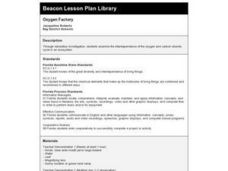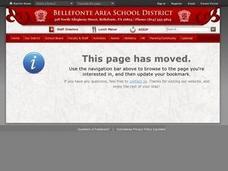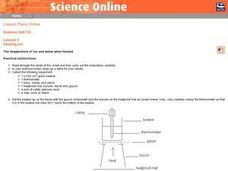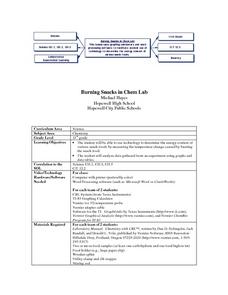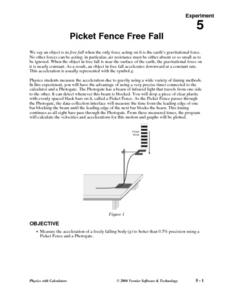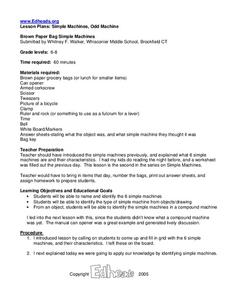Curated OER
Let Us Bond Together
Fourth graders paricipate in a demonstration about bond strengths and bond types.
Curated OER
Oxygen Factory
Fourth graders examine the interdependence of the oxygen and carbon dioxide cycle in an ecosystem through a laboratory investigation. After a lecture/demo, 4th graders complete the lab in groups.
Curated OER
"Oh Deer!"
Students play a game where half of them are deer and the others are components of habitat: food, water, shelter and space. They signify their needs by hand gestures and take what they need to their side of the game. They discuss real...
Curated OER
Transforming Food Energy: A Balancing Act
Pupils explain their role as consumers. They use a purchased calorimeter or make their own simple calorimeter to measure the energy content in selected foods. This interesting lesson really gets students thinking about what they eat.
Curated OER
The Synthesis of Some Organic Compounds And Their Representative Structures
Young scholars examine how to represent organic compounds three-dimensionally. They write a synthesis reaction for three demonstrations, and construct a three-dimensional structure using a molecular modeling set.
Curated OER
Circulatory System Design
Students identify the different parts of the circulatory system and their function. They work together to create their own model of the system and use it to determine the rate of blood flow. They answer questions related to their model.
Curated OER
Heating Ice: The temperature of ice and water when heated
Seventh graders read and follow the instructions on the worksheet. They make a table of their results. Students use about 100 cm^3 of water and ice mixture. They heat the water/ice with a Bunsen burner. Temperature is recorded every 30...
Curated OER
Heating of Water: Water Vapour
Seventh graders read the directions printed on their worksheet and follow them carefully. They set up a beaker with a tripod and Bunsen burner under it. They record the temperature of water every 30 seconds. Students graph the data and...
Curated OER
Burning Snacks in Chem Lab
Students determine the energy content of various snack foods. They measure the temperature changes in various snack foods as the foods are burned in order to determine the foods' energy content. Students create graphs and data tables of...
Curated OER
Magnets 2: How Strong is Your Magnet?
Pupils work together to test the strengths of various types of magnets. After testing, they create a graph showing how the strength changes as the distance from the magnet increases. They discuss how forces can act from various...
Curated OER
Boyle's Law
Students work in small groups and use a hand-held vacuum pump with a balloon under the dome with some air. Another deflated balloon is attached to the end where the air goes out. As the air is drawn out of the dome the first balloon with...
Curated OER
Invertebrates and Vertebrate Evolution
Young scholars explore the major characteristics of the major animal phyla. They describe adaptive features that have contributed to the success of animals on land. Students explain how primate evolution provides a context for...
Curated OER
Active Wear
Students interpret and analyze data. In this middle school mathematics lesson, students conduct an experiment in which they investigate which solar collector, black, white, or silver, absorbs the most heat. Students examine...
Curated OER
Picket Fence Free Fall
Students measure acceleration using a Picket Fence and a Photogate. In this physics lesson, students drop an object and measure the acceleration of the object free falling. They log their data using the TI.
Curated OER
The Water Cycle/States of Matter
High schoolers engage in a lesson that is concerned with the water cycle and different states of matter. They conduct research using a variety of resources in preparation for taking a quiz. Then students take the quiz in correlation to...
Curated OER
Properties of Air Activity
In this properties of air learning exercise, students experiment with a jar, a plastic bag and rubber bands to simulate that air takes up space and exerts pressure. They make observations and answer questions about their experiment.
Curated OER
Separation of Mixtures and Compounds For K Through 12
Students explore mixtures and compounds. In this lesson, students do an experiment to distinguish between mixtures and compounds. Students complete ten different phases of the experiment testing many different substances. Students will...
Curated OER
One Plus One Makes New
Students discover the properties of matter and how they change when composite materials are produced. In this informative lesson plan students write up a question and procedure to an experiment then analyze and draw conclusions...
Curated OER
You Are What You Eat!
Students calculate the calories in food samples and plan a meal based on the calorie amount. In this calories lesson plan, students also devise a work out program to burn off the calories.
Curated OER
The Inertial Balance
Students weigh objects using a triple beam balance. In this mass instructional activity, students use an inertial balance made with a metal rod to measure and graph vibrations of varying numbers of pennies in a bucket. References and...
Curated OER
Newton's Third Law of Motion
Students move through five stations demonstrating Newton's Third Law of Motion. In this Newtonian physics lesson plan, students watch as the instructor uses a firecracker to demonstrate action and reaction. The students travel to five...
Curated OER
Computer Interfacing: Frequency Measurement - The Doppler Effect
Students explore the Dollper effect by finding the frequency and velocity of sound. For this velocity lesson, students determine the impulse during a collision by using their data and a software program.
Curated OER
Simple Machines, Odd Machines
Students explore simple machines. In this physical science instructional activity, students identify six simple machines, illustrate each and identify how these machines function or can be combined to create a compound machine.
Curated OER
Simple Machines, Odd Machine
Students investigate simple machines. In this simple machines lesson, students identify the six simple machines from an object or drawing. Students also use various objects to identify the simple machines found in a compound machine.

